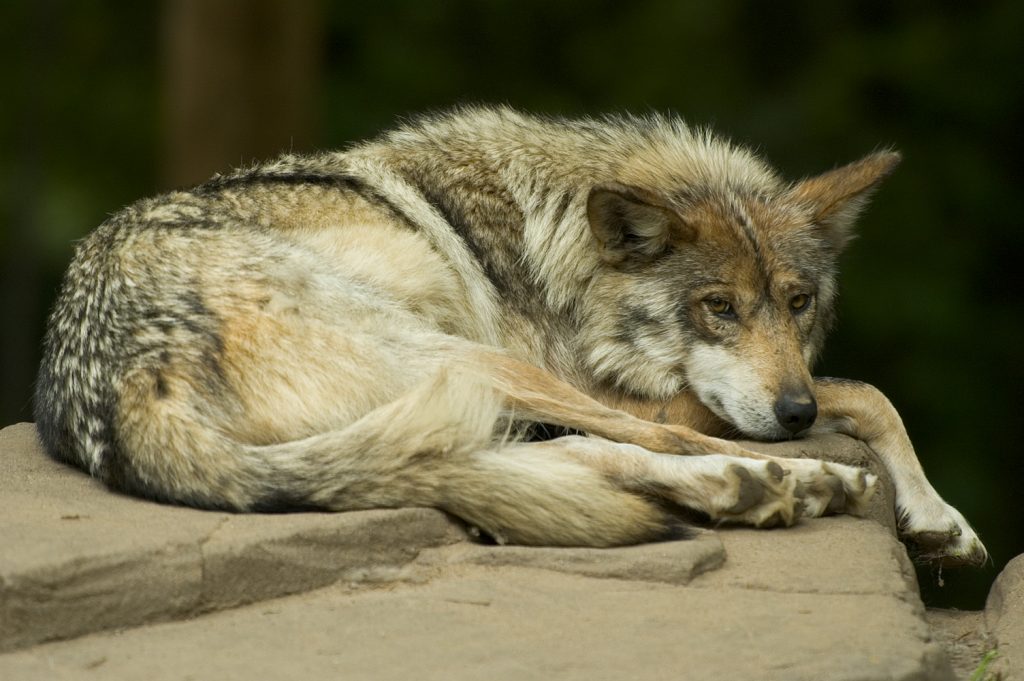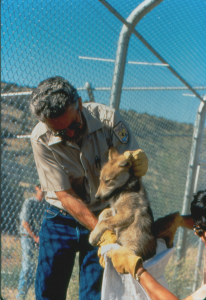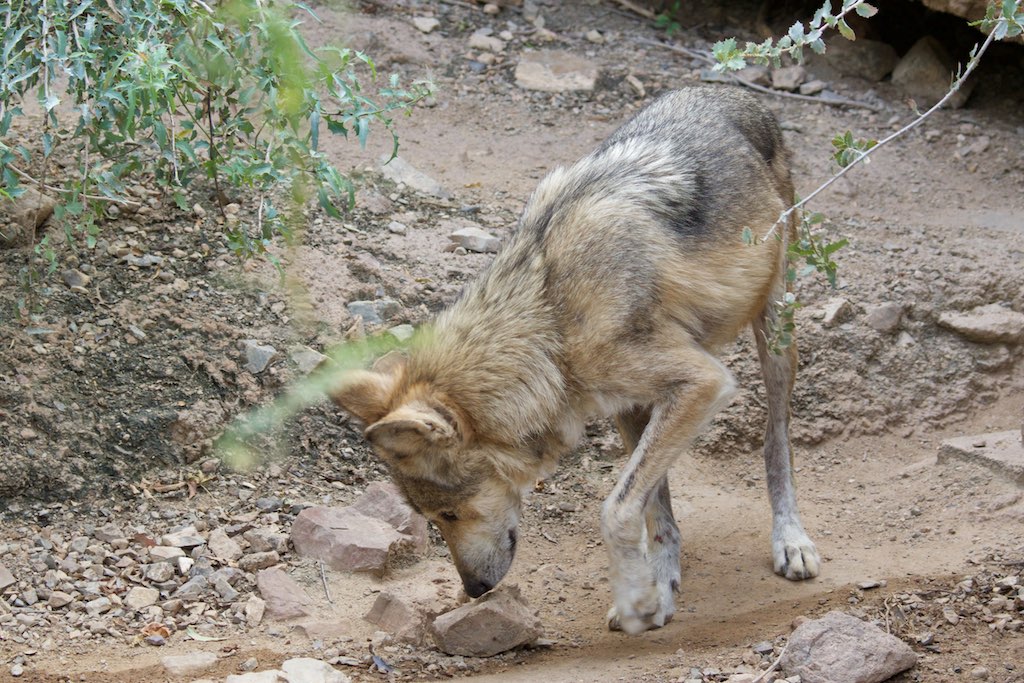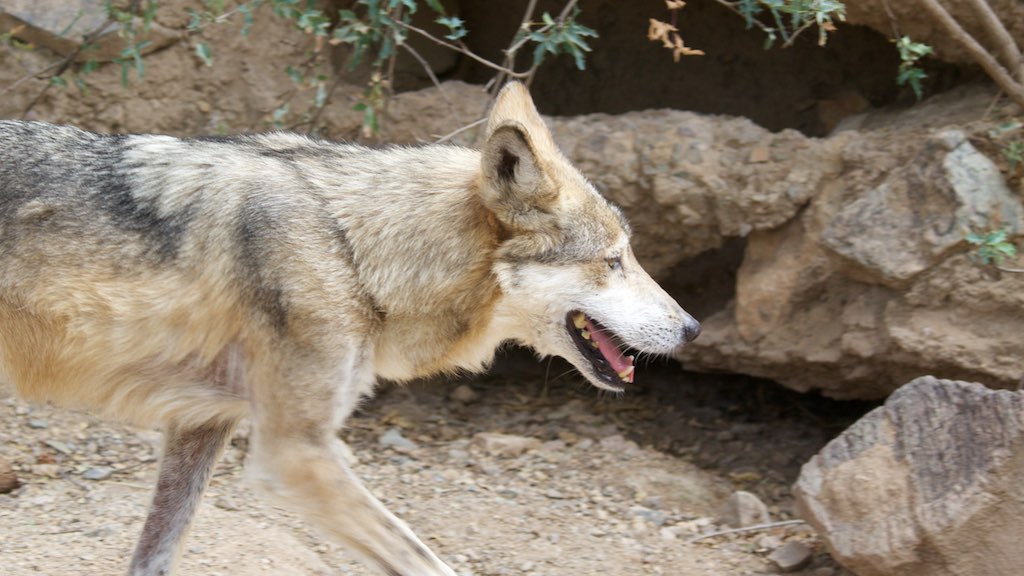Governments in CO/UT/NM/AZ Deliberately Derailed Mexican Wolf Recovery, Documents Reveal (Investigative Report)

(EnviroNews Colorado) — After decades of deliberation the final revision of the U.S. Fish and Wildlife Service’s (USFWS) Mexican Wolf Recovery Plan (the Plan) was released at the end of November, but former USFWS officials tell EnviroNews it strays far from scientists’ minimum recommendations for recovery of the gray wolf subspecies.
Meanwhile, a series of documents reveal lawmakers and agencies in Utah, Colorado, New Mexico, and Arizona — the four states central to recovery efforts — have been deliberately hamstringing wolf revival efforts for years.
David Parsons, former Mexican Wolf Recovery Coordinator for the USFWS from 1990 to 1999, told EnviroNews Colorado that instead of working to expand and stabilize wolf populations, the agency watered down the Plan and “essentially turned its mission over to the states” of Colorado, Utah, New Mexico, and Arizona — states that have repeatedly opposed many aspects of wolf recovery.
The Mexican wolf (Canis lupus baileyi), a.k.a. “el lobo,” was hunted to near-extinction during the late 1800’s and 1900’s. In 1976, it gained protection under the Endangered Species Act (ESA) and by 1982 the USFWS launched the original Mexican Wolf Recovery Plan to keep the keystone predator from being wiped off the face of the earth.
The agency’s captive breeding program released three lineages of Mexican wolves into the wild in the U.S. starting in 1998, with Mexico releasing wolves in 2011. Today, 113 of these creatures inhabit central and southern Arizona and New Mexico while 31 wolves live in the northern Sierra Madre Occidental of Chihuahua and Sonora in Mexico.
Despite this modest rebound in numbers, poor genetic variability and limited high-quality habitat free from human encroachment means the future of the Mexican wolf remains bleak.
In 2014, Parsons joined a coalition of conservation groups in a lawsuit in the United States District Court for the District of Arizona against the USFWS for delaying completion of the Plan. In 2016, a court settlement required the agency to finish the plan by November 2017.
To achieve full recovery, the final Plan recommends the release of more captive-bred specimens in an effort to establish two “genetically diverse Mexican wolf populations distributed across ecologically and geographically diverse areas in the subspecies’ range in the United States and Mexico.” The estimated $178 million cost of recovery is to be borne by federal and state governments and NGOs.
The Plan’s ultimate goal is to increase Mexican wolf populations in the U.S. to 320 wolves and 200 in Mexico over the next 25 to 35 years, at which point the USFWS would remove the subspecies from the Endangered Species List.

In late 2011, the USFWS convened the Science and Planning Subgroup of the Recovery Team (the Subgroup) — staffed with independent scientists — which recommended a minimum of 750 wolves in the U.S. and 100 in Mexico, with three separate populations of 200 to 300 wolves, before delisting.
Parsons said that faced with these numbers, ranchers “just went ballistic.” Though stakeholders were sworn to secrecy, the Subgroup’s internal working draft was leaked and pro-ranching and hunting voices, including U.S. Senator Orrin Hatch (R-UT), pushed back hard against the Plan.
“They just blew the thing up in the media,” said Parsons. “Fish and Wildlife Service, true to fashion reacted by just quitting — they canceled the next meeting of [the Subgroup]… and never held another one.”
In November 2017, the U.S. Fish and Wildlife Service Southwest Region’s Biological Report for the Mexican Wolf determined that wolf numbers wouldn’t be based on science alone, but also what is “socially acceptable in light of the expected ongoing issues around livestock depredation and other forms of wolf-human conflict.”
“They essentially asked the states how many wolves they could tolerate,” Parsons said. “They called it a social tolerance limit based on their perception of social tolerance and not backed by any science whatsoever.”
Parsons also pointed out that, aside from the special interests associated with ranching and hunting, polls have shown the vast majority of the public in Arizona, New Mexico, Utah, and Colorado are in support of Mexican wolf reintroduction and recovery.

Another bone of contention within the Plan is the way it limits the Mexican wolf’s range to south of Interstate 40, which runs east to west across northern New Mexico and Arizona.
The Science and Planning Subgroup recommended including sections of eastern Arizona and New Mexico, the Grand Canyon region of northern Arizona and southern Utah, and the Southern Rockies area of northern New Mexico and southern Colorado as “three major core areas of suitable habitat… capable of supporting Mexican wolf populations of sufficient size to contribute to recovery.”
A 2015 study published in Biological Conservation concluded that “most of the [Mexican wolf’s] historic range in Mexico is currently unsuitable due to human activity” with a high probability of wolves in those regions being killed by people.
However, due to “geopolitical reasons,” the USFWS chose to leave out the Grand Canyon and Southern Rockies regions in the Plan, according to notes from an April 2016 Mexican Wolf Recovery Planning Workshop in Mexico City, Mexico.

Parsons said the reason these two areas were excluded involved pushback from the state governments of Colorado, Utah, New Mexico, and Arizona, maintaining that “state game and fish departments are controlled by game commissions and game commissions in most western states are appointed by the governors and they are stacked primarily with hunters and ranchers.”
“State governments are generally beholden to livestock and hunting interests, particularly outfitters,” wrote Bryan Bird, Southwest Director for Defenders of Wildlife, in an email exchange with EnviroNews Colorado.
He said that the opposition is “emotional and not based in fact,” pointing out that wolf reintroduction in the Northern Rockies hasn’t had “any measurable affect on hunting success and there are programs in place for wolf and livestock coexistence.”
While some may disagree with the assertions made by Parsons and Bird, there’s no question these four states have opposed myriad components of wolf recovery for years.
In 2015, the governors of Colorado, Utah, New Mexico, and Arizona sent a joint letter to then-Secretary of the Interior Sally Jewell and USFWS Director Daniel Ashe stating they “do not support recovery of the Mexican wolf across regions and landscapes that are not part of the subspecies’ historical range.”
The letter insisted the states would “oppose the expansion, release, and occupancy” of Mexican wolves north of I-40 and that the focus of the recovery should be in Mexico. The governors argued the Endangered Species Act does not “specifically authorize” recovery of a species outside its historical range, and asserted that to do so would be “neither necessary nor scientifically supported.”
Parsons contended that the historical range question isn’t “settled science,” explaining that for a “species that was once continuously distributed from Mexico City to the Yukon and is capable of dispersing [hundreds], even thousands, of miles, it is impossible to draw a bright line that demarcates the range boundaries of different subspecies.”
Historical range aside, he said “the key issue that gets overlooked in this debate is where is the best available habitat for recovery of Mexican wolves today?”

In a quest for clarity, EnviroNews contacted all four of the governors’ offices involved. Arizona and New Mexico did not respond, but the offices of Hickenlooper (D-CO) and Herbert (R-UT) did. EnviroNews made relentless attempts with both Governors to get one query answered. That question:
In a joint letter dated November 13, 2015, signed by Governors Hickenlooper, Herbert, Ducey and Martinez, to then-Secretary Sally Jewell and Director Dan Ashe, the Governors stated, “Our States oppose the expansion, release, and occupancy of Mexican wolves north of I-40 in the States of Arizona and New Mexico and into Utah and Colorado.” Since the entire states of Colorado and Utah lie north of I-40, is your position that Mexican wolves have no place in Colorado or Utah’s wilderness whatsoever?
The answers to that question were less than satisfactory. After significant delays, Shelby Wieman, Deputy Press Secretary for Governor Hickenlooper, told EnviroNews the Governor simply couldn’t offer any clarity because, “at this point, given the complexity of the plan, and the issue itself, we’re just going to stick with [our original] statement. That’s all that we would like to comment at this point,” Wieman concluded.
The statement Wieman was referring to comes from Bob Broscheid, Director of Colorado Parks and Wildlife, who said in a statement to EnviroNews Colorado:
Our initial sense is that this is good plan from a Colorado perspective, though we continue to review it to ensure our interests [are] adequately reflected. The plan does appear to be based on sound, and the best available science, reflecting the true historic range of the wolf. Colorado appreciated the opportunity to participate in the entire recovery planning process.
After asking Herbert’s office whether el lobo should be allowed to exist at all in Utah, following days of repeated requests and what seemed like an initial willingness to answer the question, Anna Lehnardt, Digital Media Director for Governor Herbert, told EnviroNews, “I’ve checked in on this, and we don’t have a comment at this time.”
The 2015 joint governor’s letter also brought up a concern with the possibility of the Mexican wolf mating with the gray wolf (Canis lupus), which the governors said would “threaten the genetic status of Mexican wolves” and impede recovery. But the governors aren’t the only officials working to stymie the return of the Mexican wolf across these western states.
In 2016, the Colorado Parks and Wildlife Commission passed a resolution opposing the release of any wolf subspecies into the state, while urging the Mexican wolf remain within its historic range.
Also in 2016, the New Mexico Department of Game and Fish sued USFWS to stop the release of captive wolves into the state. While the preliminary injunction was initially granted, it was later overturned and the case is now back in federal court.
In 2011, the New Mexico Game Commission backed out of the Mexican Wolf Recovery program altogether.
In 2010, the Arizona Game and Fish Department sent a letter to Congress asking for the gray wolf, including the Mexican wolf, to be delisted from the Endangered Species Act.
In 2010, Utah passed Senate Bill 36 requiring its own Division of Wildlife Resources to remove any wolves found within state lines. The state also threatened legal action against the USFWS if the Plan recommended expanding the range of Mexican wolves into the state.
Regarding Senate Bill 36, EnviroNews also asked Herbert’s office, “In March of 2010 you signed Senate Bill 36 into law directing Utah’s Division of Wildlife Services to remove any wolf found within Beehive State boundaries. Is it your position that wolves have no place in Utah’s ecosystem at all?” To which EnviroNews got the same answer from Lehnardt: “We don’t have a comment at this time.”

While the future of the Mexican wolf is less dire than it was in decades past, Parsons and conservationists believe the current Plan is insufficient for full recovery of the subspecies.
“Limiting the numbers and range of the Mexican gray wolf is a major blow for ecologically relevant recovery,” Bird concluded.
On November 29, Earthjustice, on behalf of Parsons, the Center for Biological Diversity, Defenders of Wildlife, the Endangered Wolf Center, and the Wolf Conservation Center, filed a sixty-day notice of intent to sue for violations of the Endangered Species Act in the Plan.
The groups argue the Plan “contains shortcomings that will hinder — if not prevent — Mexican wolf recovery and [that it] threatens to lead to the extinction of this iconic species.”
On the heels of its minor rebound from the brink of annihilation some thirty-six years after the launch of the original Mexican Wolf Recovery Plan, the fate of this majestic and misunderstood animal will now be in the hands of the U.S. federal court system.
OTHER GREAT STORIES ABOUT WOLVES FROM ENVIRONEWS
Victory for Mexican Gray Wolves: Court Stops Injunction, Allows Releases from Captivity to Proceed
(EnviroNews Nature) – Denver, Colorado – The U.S. Fish and Wildlife Service (USFWS) can continue to release Mexican gray wolves (Canis lupus baileyi) from captivity into the wild after the 10th Circuit Court of Appeals overturned an injunction halting the program on April 25, 2017, which conservationists say…
Wyoming Wolves Stripped of Endangered Species Act Protection – Shoot-on-Sight Policy Restored
(EnviroNews Wyoming) – Gray wolves (Canis lupus) will no longer be protected under the Endangered Species Act (ESA) in the state of Wyoming. That was the ruling by the U.S. Court of Appeals for the District of Columbia Circuit, on March 3, 2017, which also happened to be…
These Species Should Be ‘Endangered’ But Aren’t Due to Political Horse Trading, Report Reveals
(EnviroNews Colorado) – Special-interest politics – not sound science – decides the fate of species on the brink of extinction in the U.S., according to a new expose’ from the Endangered Species Coalition. The report, Suppressed: How Politics Drowned Out Science for Ten Endangered Species (Suppressed), profiles ten…
It’s Done: Trump Signs HJR 69 into Law Allowing Slaughter of Alaskan Bear Cubs, Wolf Pups
(EnviroNews Alaska) – Washington D.C. – On April 3, 2017, President Donald Trump signed House Joint Resolution 69 (HJR 69) into law. The legislation rescinds the U.S. Fish and Wildlife Service’s (USFWS) 2016 Alaska National Wildlife Refuges Rule (Refuge Rule). The Refuge Rule was enacted to protect native…
Bill Allowing Slaughter of Alaskan Bear Cubs, Wolf Pups, Sails Through Senate to Trump’s Desk
(EnviroNews Alaska) – Washington D.C. – On March 21, 2017, in a 52-47 vote, the Senate passed House Joint Resolution 69 (HJR 69), a Congressional Review Act resolution to rescind the U.S. Fish and Wildlife Service’s (USFWS) Alaska National Wildlife Refuges Rule (Refuge Rule), which has been in…
Center for Biological Diversity Sues Trump for Signing HJR 69 Allowing Slaughter of Bear Cubs, Wolf Pups
(EnviroNews USA Headline News) – Washington D.C. – The Center for Biological Diversity (the Center) filed a lawsuit in federal district court in Anchorage, Alaska, on April 20, 2017, against the U.S. Department of Interior (Interior) and Secretary Ryan Zinke, after President Donald Trump signed House Joint Resolution…
Shocking Video Shows the Guts of HJR 69: Trump’s Alaskan Bear Cub/Wolf Pup Killing Bill
(EnviroNews Nature) – Playground, a news and media site, has produced a graphic video showing shocking hunting practices that are now legal in Alaska’s wildlife refuges. These methods, which have been called “scientifically indefensible” and “unsportsmanlike” by defenders of animal rights, include hunting bears from aircraft, killing bear…
Elk Hunting Group Wants to Expand Wolf-Killing Derby into Montana: $1,000 Bounty per Wolf
(EnviroNews Montana) – The Rocky Mountain Elk Foundation (RMEF), which has funded wolf-killing derbies in Idaho to the tune of $150,000 since 2013, is now seeking to expand its $1,000-per-kill bounty program to the neighboring state of Montana. RMEF provides funds to the Foundation for Wildlife Management (F4WM),…
WA State Stops Bloodshed After Massacring Profanity Peak Wolf Pack To Appease Cattle Ranchers
(EnviroNews Washington) – Olympia, Washington – The Washington Department of Fish and Wildlife (WDFW) announced October 19, 2016, that it would spare the remaining four members of the now demolished Profanity Peak Wolf Pack, after already having killed seven of its wolves (Canis lupus) to appease cattle ranchers….
Five Environmental Groups Sue USDA Over Idaho Wolf-Killing Program
(EnviroNews Idaho) – Boise, Idaho – On June 1, 2016, five prominent environmental organizations filed a lawsuit in federal district court against the United States Department of Agriculture’s (USDA) Wildlife Services for killing over 650 wolves in the state of Idaho over the past decade. Wildlife Services is…
Federal Government Sued For Killing Wolves in Oregon
(EnviroNews Oregon) – Five environmental groups filed a lawsuit on February 3, 2016, in U.S. District Court against the federal agency Wildlife Services, over what they say is the illegitimate killing of wolves in the state of Oregon. WildEarth Guardians, Center for Biological Diversity, Predator Defense, and Project…
Idaho Wolf-Killing Contest Killed for One More Year – Kind of…
(EnviroNews Idaho) – Facing a lawsuit from conservation groups, the Bureau of Land Management (BLM) has revoked a permit allowing for a “predator derby” to take place on approximately three million acres of public lands in north-central Idaho near the town of Salmon. The derby originally called for…
California the First to Ban Predator Prizes While Idaho Forges Ahead With Wolf-Killing Derby
(EnviroNews California) – Van Nuys, CA – Will not allowing prizes for California wildlife hunting derbies deter such events from taking place? Groups like Project Coyote certainly think so. On December 3, with a 4 to 1 vote, the California Fish and Game Commission passed a motion prohibiting…
Poll Closed: Should U.S. Government Maintain a Wolf-Killing Program? Yes or No? – View Results
(EnviroNews Polls) – In December of 2015, several environmental groups, spearheaded by WildEarth Guardians, won a pivotal lawsuit against Wildlife Services, a U.S. Department of Agriculture (USDA) agency, for its wolf-killing program in Washington State. On February 3, 2016, WildEarth Guardians, in concert with four other groups, filed…
FILM AND ARTICLE CREDITS
- Josh Schlossberg - Journalist, Author
- Emerson Urry - Editor


![Leading the Charge for America’s Wild Horses on Capitol Hill: NBA/NFL Celeb. Bonnie-Jill Laflin: ‘[Politics] won’t stop us from fighting’](https://cf-images.us-east-1.prod.boltdns.net/v1/static/1927032138001/f46b2158-cead-47f0-ab44-4b027059411a/4e4afcf2-937d-4a9d-acba-1b82e2efd4c6/160x90/match/image.jpg)



3 thoughts on “Governments in CO/UT/NM/AZ Deliberately Derailed Mexican Wolf Recovery, Documents Reveal (Investigative Report)”